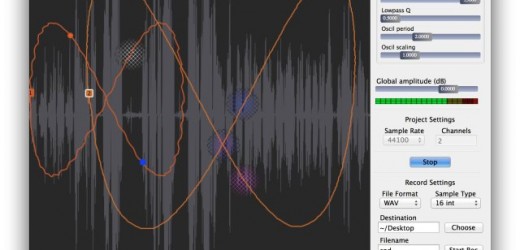Soundgrain is a graphical interface where users can draw and edit trajectories to control granular sound synthesis. Soundgrain is written with Python/WxPython and uses Pyo as its audio engine.
GNU GPL v3 (c) Olivier Belanger 2015

Soundgrain version 5.0.0 features a brand new granulation engine, with much more controls and capabilities than the previous one. It’s worth a try!
Download binaries and sources for Soundgrain 5.0.0
OSX (10.6 to 10.10) | WINDOWS (7, Vista, 8) | SOURCE CODE (all platforms)
The SVN repository at http://code.google.com/p/soundgrain/ is used to keep track of the source code and for bug reports.
To run Soundgrain from sources, the following softwares must be installed on the system:
- Python 2.6 or 2.7 (recommended)
- WxPython 3.0
- pyo 0.7.5
- Python markdown library
Then, in a terminal window, go to the Soundgrain folder and launch the program:
cd /path/to/soundgrain/folder
python SoundGrain.py
Getting Started
Getting sound with Soundgrain is easy:
– Load a soundfile on the drawing surface (Menu -> File -> Open Soundfile…)
– Draw a granulator trajectory on the drawing surface using the mouse
– Activate the audio by clicking on the “Start” button.
At this point you should be hearing sound.
After that, you can explore by drawing more trajectories (of different kind), playing with the granulator controls (Menu -> File -> Open Granulator Controls) or with the effect balls (Menu -> FxBall). You can record the generated sound to the disk using the “Record Settings” section at the bottom of the control panel.
http://ajaxsoundstudio.com/software/soundgrain/
